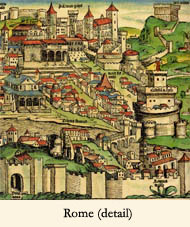 The first book printed in Hungary has come out of Andreas Hess' office in Buda, 1473. The early introduction of printing about two decades after the 42-line Bible by Gutenberg is a remarkable event, even if the Buda workshop was short-lived. The invention of "artificial script" appeared, following the German-speaking region, first in Italy (1465), and next in France (1471). It was simultaneously with the Netherlands that the first printed book was issued in Hungary, thus preceding e.g. Spain or England.
The first book printed in Hungary has come out of Andreas Hess' office in Buda, 1473. The early introduction of printing about two decades after the 42-line Bible by Gutenberg is a remarkable event, even if the Buda workshop was short-lived. The invention of "artificial script" appeared, following the German-speaking region, first in Italy (1465), and next in France (1471). It was simultaneously with the Netherlands that the first printed book was issued in Hungary, thus preceding e.g. Spain or England.

THE ESTABLISHING OF ANDREAS HESS' PRINTING SHOP
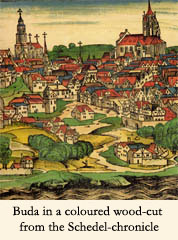 Hess set to work possibly in summer 1472 to prepare the book known commonly as the Buda Chronicle. The work took ten months and was ready by 1473 Pentecost as we are informed from the closing lines (colophone) of the book. Andreas Hess, a printer of German origins after his name, has arrived to Buda from Rome, from the office of Georg Lauer, bringing with himself both practical knowledge of printing and cast letters. Instruments necessary for installing the printing shop were probably made by local craftsmen in Buda. Composing was done by hess himself, moreover, very likely the whole printing procedure, thus explaining why the making of his first book took such a long time.
Hess set to work possibly in summer 1472 to prepare the book known commonly as the Buda Chronicle. The work took ten months and was ready by 1473 Pentecost as we are informed from the closing lines (colophone) of the book. Andreas Hess, a printer of German origins after his name, has arrived to Buda from Rome, from the office of Georg Lauer, bringing with himself both practical knowledge of printing and cast letters. Instruments necessary for installing the printing shop were probably made by local craftsmen in Buda. Composing was done by hess himself, moreover, very likely the whole printing procedure, thus explaining why the making of his first book took such a long time.
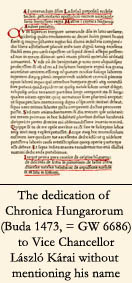 Andreas Hess must have arrived to Hungary on the encouragement of Cardinal János Vitéz, Archbishop of Esztergom and royal chancellor at the time, while the person mediating between them was László Kárai vice-chancellor. Cardinal Vitéz, outstanding figure of Hungarian humanistm, has already been informed about this new possibility of text-multiplying. However, unfortunately as a result of the conflict arising between King Matthias Corvinus and hm, the newly arrived printer remained without a constant patron in Buda. That is why the dedication of his first product, the Chronica Hungarorum was not addressed to the cardinal, falling out of royal grace by then, and soon dying (1472), but to Vice Chancellor Kárai, who possibly gave accommodation to the printer in one of the buildings of the royal castle in Buda.
Andreas Hess must have arrived to Hungary on the encouragement of Cardinal János Vitéz, Archbishop of Esztergom and royal chancellor at the time, while the person mediating between them was László Kárai vice-chancellor. Cardinal Vitéz, outstanding figure of Hungarian humanistm, has already been informed about this new possibility of text-multiplying. However, unfortunately as a result of the conflict arising between King Matthias Corvinus and hm, the newly arrived printer remained without a constant patron in Buda. That is why the dedication of his first product, the Chronica Hungarorum was not addressed to the cardinal, falling out of royal grace by then, and soon dying (1472), but to Vice Chancellor Kárai, who possibly gave accommodation to the printer in one of the buildings of the royal castle in Buda.
From the point of view of the first printing shop in Hungary, the dedication of the Chronica as the only textual document providing hints at the circumstances of printing, is of major importance. Its significance was realized very early not only by scholars dealing with the history of printing, but by cultural history as a whole, especially, because there is no other written source extant about the beginnings of printing in Hungary.

THE PRINTING SHOP OF ANDREAS HESS
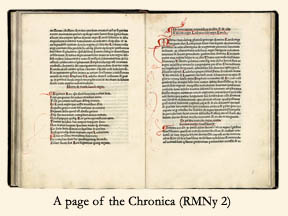 Reconstructing his process of printing it can be taken for certain, that he was equipped with a single, half-format press. His aim was probably to be ready with the printing of the Chronicle by the annual market to be held in Buda at Pentecost (1473). According to its colophone he finished it he day before Pentecost, i.e. 5th June 1473.
Reconstructing his process of printing it can be taken for certain, that he was equipped with a single, half-format press. His aim was probably to be ready with the printing of the Chronicle by the annual market to be held in Buda at Pentecost (1473). According to its colophone he finished it he day before Pentecost, i.e. 5th June 1473.
Taken its size, Andreas Hess' Buda office did not count among the significant ones of his age. His set of cast types amounting to half a counter and his single press could disappear easily without leaving back any trace. Perhaps it is due to the small scope and poor possibilities that it failed to draw the attention of King Matthias to himself. There is no trace of Hess continuing the printing activity after 1473 either in Buda, or elsewhere in Europe: neither his name nor his printing letters emerge anywhere in Europe.
 |
The colophon of Chronica with the place and date of printing and the name of the first printer active in Hungary |

THE PUBLICATIONS OF ANDREAS HESS
The first print known commonly as the Buda Chronicle (Chronica Hungarorum) is a Latin language history of the Hungarians compiled from several chronicle-manuscripts. It was, like most incunables of the age, printed without a title page, the place and date of finishing it, together with the printer's name is given in the closing lines of the volume. It was printed with one, renaissance roman type, coming from a Rome printing shop, as mentioned above, titles, or capital letters were lined or underlined afterwards with hand, with red ink. The small folio volume of 133 printed pages does not contain any other decoration.
|
|
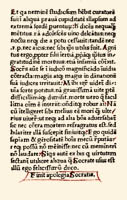 |
The first page of Basilius Magnus De legendis poetis (Buda 1473 = GW 3702) |
The first page of Xenophón's Apologia Socratis (Buda 1473) |
The last page with the closing lines of Xenophon's work |
The other book produced by Hess in Buda contains two works in one volume: the first being the work of Basilius Magnus De legendis poetis and the second Xenophon's Apologia Socratis, both in Latin. As compared to the Chronica this second print is of smaller format and made up of only 20 leaves and is printed with the same letter type as the Chronicle. Only the initials of the printer and the place is denoted at the end of the volume: "Budae A. H."
 |
It is only at the end of Basilius' work, i.e. the middle of the print, where the reader is informed about the place of printing and the initial letters of the printer |

THE AFTERLIFE AND THE COPIES OF THE CHRONICA HUNGARORUM
The Chronica was probably printed in 200-240 copies, this number being common among contemporary incunables. Ten copies have survived, they are precious incunables of different libraries all over the world. Of these two are in Hungary, both in Budapest: one in the National Széchényi Library and the other in the University Library. Of the ten extant copies there are only two that have original bindings, products of the Buda binding workshop making also bindings for the famous Corvina library. The finely decorated brown binding covering the copy of the Prague National Library is unique in its kind.
The value of the Chronica is indicated by the fact that at a 1990 Munich auchion one copy fetched 420 thousand German marks, the highest price that any printed book had ever been sold for in Germany.
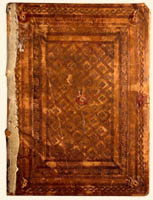 |
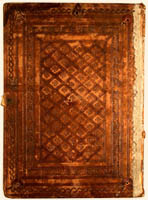 |
Front and back of the original binding of a copy of Chronica, coming from the Buda workshop (courtesy of Národní knihovna České republiky, Praha) |
It seems that the issuing of Chronica as the first product of a newly established office was a good choice, becuse some years later there were no copies left and the text of the Buda Chronica began to spread in manuscript copies. 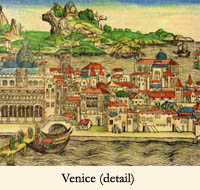 During the reign of King Matthias Corvinus Hungary was in the focus of European interest, and this interest continued, as it is demonstrated by the great success of the Thuróczy-chronicle -- relying mostly on the Buda chronicle -- which was printed twice within three months: once in Brno in March 1488 and once in Augsburg in June, the same year.
(RMK III 16 és RMK III 15)
During the reign of King Matthias Corvinus Hungary was in the focus of European interest, and this interest continued, as it is demonstrated by the great success of the Thuróczy-chronicle -- relying mostly on the Buda chronicle -- which was printed twice within three months: once in Brno in March 1488 and once in Augsburg in June, the same year.
(RMK III 16 és RMK III 15)

THE PAPER OF HESS' PRINTED BOOKS
In all the extant copies of the Chronica the same two watermarks are varying: the scales pending on a star, respectively on a 8-shape. There is only one in the Basilius-Xenophon book: here the scales are hanging from an Y-shape. These were all watermarks common in papers used for codices in Hungary, and they were the products of one of the paper-mills of the Republic of Venice.
|
|
Watermarks of the Chronica |
The watermark of Hess' other print: the volume containing the works of Basilius Magnus and Xenophon |

PRINTING TYPE
<<back to the top <<

LITERATURE:
Régi Magyarországi Nyomtatványok 1. By Borsa Gedeon, Hervay Ferenc, Holl Béla, Käfer István. Budapest 1971 (for short: RMNy)
Varjas Béla: Das Schicksal einer Druckerei im östlichen Teil Mitteleuropas (Andreas Hess in Buda) In: Gutenberg Jahrbuch 1977. 43. - Borsa Gedeon: Vitéz János és a könyvnyomtatás. In: MKsz 1991. 113-115. - Fitz József: Hess András, a budai ősnyomdász. Bp. 1932. 119-120. - Borsa Gedeon: A budai Hess-nyomda új megvilágításban. In: MKsz 1973. 141-149. - About Hess' printing types see V. Ecsedy Judit: A régi magyarországi nyomdák betűi és díszei 1473-1600. Budapest. 2004. 41-42./Hungaria typographica 1./
Gesamtkatalog der Wiegendrucke I-VIII/1. Berlin 1925-1940 (for short: GW)
Schedel, Hartmann: Weltchronik. Nürnberg 1493, Koberger
Facsimile-editions:
Basilius Magnus, De legendis poetis - A költők olvaásáról. Xenophon: Apologia Socratis - Socrates védőbeszéde. Ford.: Ritoók Zsigmond, bev.: Soltész Zoltánné. Hungarian translation and facsimile-edition. Budapest 1978.
Chronica Hungarorum, A Budai Krónika. Bev.: Fraknói Vilmos. Hasonmás kiadás, Bp. 1900.
Chronica Hungarorum, Transl. to Hungarian by Horváth János, afterword by Soltész Zoltánné. Facsimile-edition. Budapest. 1973.
Digitális edition:
Chronica Hungarorum, Buda 1473 - Digitális kincstár - Digital treasury (Bp., Országos Széchényi Könyvtár 2006.)